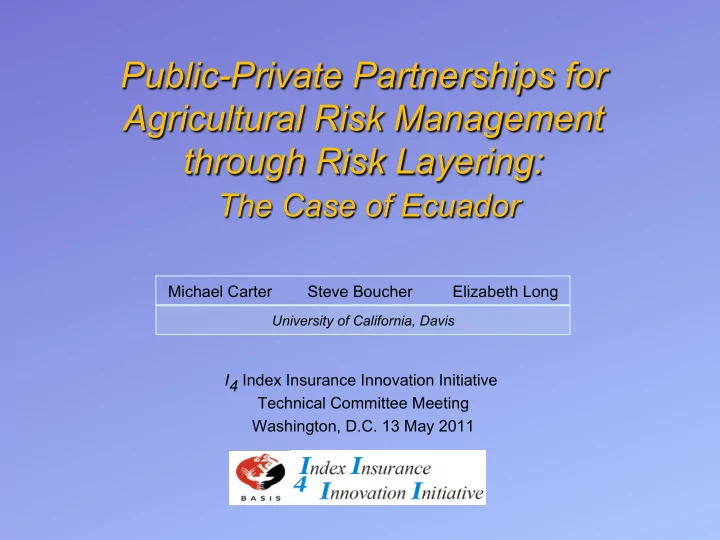

Public-Private Partnerships for Agricultural Risk Management through Risk Layering: The Case of Ecuador Michael Carter Steve Boucher Elizabeth Long University of California, Davis I4 Index Insurance Innovation Initiative Technical Committee Meeting Washington, D.C. 13 May 2011
Parallel Efforts for Low-Cost Risk Management • Governments are increasingly turning to index insurance for catastrophic risk management • Private sector index initiatives • Goal to explore gains of unifying efforts and identify specific division of labor between private and public sector, challenges, etc.
Structure of Presentation • Characteristics of coastal Ecuador • Data for Ecuador • Define Risk Layers • Contract design • Challenges moving forward
Coastal Ecuador • Palenque is canton in Los Ríos (13) • Lowland and tropical • Two rainy seasons • Irrigated rice is primary crop for smallholders
Data for Ecuador • ESPAC – government annual yield survey – 2000-2010 – Sample structure: randomly select segmentos (agricultural census tract 200-500 ha) and interview all farmers • Same segmentos revisited every year • Select segmentos to be representative of province – Unidad Primaria de Muestreo (UPM) next higher level, contract “written” at UPM level
Risk Layers Risk Retention Layer Commercial Risk Layer Catastrophic Risk Layer
Risk Transfer Contract Catastrophic Risk Layer Commercial Risk Layer Risk Retention Layer
Risk Transfer Contract: Catastrophic Risk Layer
Risk Transfer Contract: Commercial Risk Layer
Risk Transfer Contract: Unified A C B
Institutional Challenges: Information Augmentation • Challenge of increasing data quantity and quality (good start in Ecuador) • Short-run challenge in Ecuador of writing contracts based on area yield data from small areas (optimal balance: coverage vs. basis risk) • General challenge: The case for increased public investment?
Institutional Challenges: Delivery Mechanisms for Public Insurance • Targeting – Conceptually, who do you want to insure? (crops, max farm size, … ) – Practically, how do you identify this population? • Outreach – How do you make them aware they are insured -- and thus change behavior? • This is a concern if catastrophic insurance is publicly provided (not purchased) • In Peru many farmers didn’t know they were insured • Delivery – How do you design delivery mechanism of indemnities to insured population?
• Questions? Thank you
Institutional Challenges: Coordination between sectors • Ecuadorean case – Govt. provides premium subsidy for commercial insurance; – MAYBE DROP THIS SLIDE AND FOCUS ON PREVIOUS 2 CHALLENGES …
Recommend
More recommend